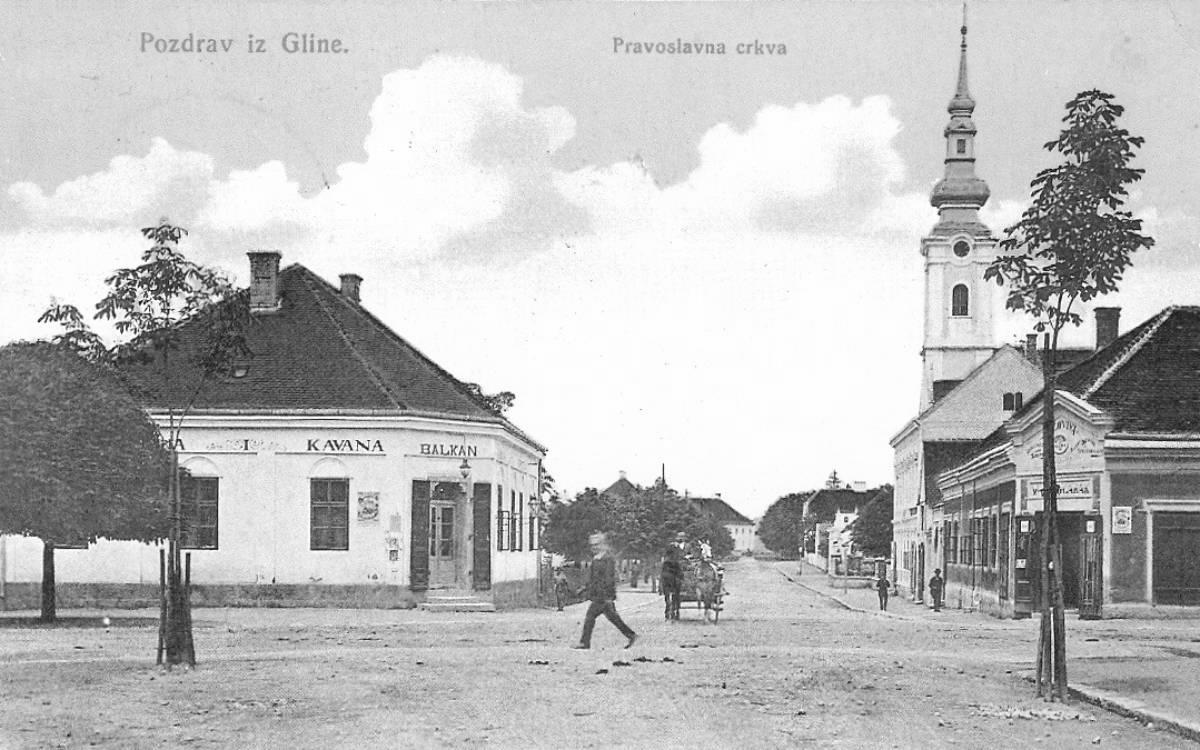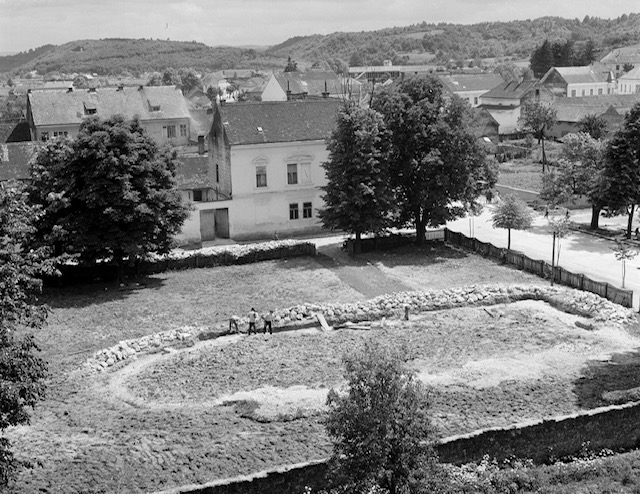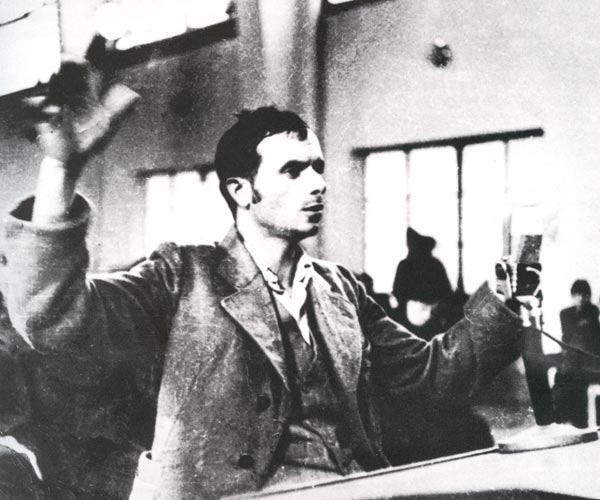|
|
Period:
Second World War
Region:
Bania
The Croatian massacre in Glina Orthodox Church - Banija 1941
The Croatian massacre in Glina Orthodox Church took place on 29 July 1941 in Glina, Banija region where 1,764 people of Serbian nationality were killed. The perpetrators were Croatian fascists (Ustasha), and the victims were local civilians of the Serb population from the town of Glina and the surrounding area.
People from the town of Glina were mostly killed earlier in the slaughter on 11-12 May 1941 at Canal and Hadjer.
At the end of July 1941, the members of Ustasha units entered a village near Glina and Vrginmost (the Kordun region), captured Serbs mostly by fraud promising them they would be "baptized" and together with their children and elderly men, brought them to Glina and closed them in the Orthodox church.

On the eve of Ilindan (the day when the Serbian Orthodox Church celebrates Elijah, the prophet) 1,941 victims were slaughtered. The only survivor was Ljuban Jednak.
Ten years after the crime, the communist authorities raised a common ossuary memorial for all victims. On 4 July 1969, the people of Banija raised the Memorial House of Victims of Fascism in Glina with their own contributions.
After the genocidal operation "Storm" from 1995, the Croatian authorities renamed the Memorial Home of the Victims of Fascism in Glina into the Croatian National Home.
BACKGROUND
The Kingdom of Serbs, Croats, and Slovenians, the first South Slavic state, later renamed into the Kingdom of Yugoslavia, was created after the First World War, with its promulgation on December 1, 1918, in Belgrade. The territory of the Yugoslav Kingdom was divided into banates in 1929 and the structure of its government was a parliamentary monarchy.

Proclamation of the first South Slavic state
The royal title was held by the Serbian Karadjordjević dynasty. It consisted of Southern Serbia, Šumadija, Raška, Kosovo and Metohija, Eastern Serbia, Montenegro, Bosnia and Herzegovina, Vojvodina, Slavonija, a small part of Dalmatia, the Dubrovnik Republic, Lika, Kordun, Banija, Zagorje, Gorski Kotar, and Slovenia.
After the assassination of King Alexander I Karadjordjević in Marseilles on October 9, 1934, the country was ruled by regents: Prince Paul Karadjordjević, Dr. Radenko Stanković, and Dr. Ivo Perović, and the government was formed by Dragiša Cvetković and Vlatko Maček.

Belgrade's demonstration on March, 1941.
In the mid-1930s, Europe witnessed the rise of Nazism and Fascism, especially in Germany, Italy, and Spain. This led to the formation of the Tripartite Pact, on September 27, 1940, between Germany, Italy, and Japan. In the next months, this alliance was joined by the following countries: Hungary, Bulgaria, Romania, Albania, etc. Thus, the Kingdom of Yugoslavia found itself surrounded by Axis Powers.
In Vienna, on March 25, 1941, the signing of the protocol between the Kingdom of Yugoslavia and Nazi Germany took place regarding the passage of German and Italian troops through Yugoslav territory. Among the patriotic forces of the Kingdom of Yugoslavia, this was interpreted as treason, and the British and Soviet intelligence officers organized a military coup and demonstrations on March 27, 1941 in Belgrade resulting in the overthrow of the governorship led by Prince Paul and putting on the throne a minor king Petar II Karadjordjević.
Hitler changed the plans and the armed forces' plans to attack Greece, were diverted to the Kingdom of Yugoslavia.
THE SITUATION IN GLINA
Glina is the town in the Banija region and for centuries it was located on the border of the Ottoman Empire and Vojna Krajina (Military Border Region).
It lies on the river Glina and the Zrinska Mountain is in its vicinity. First communities in this area are traced back to the 13th century.
This area had been desolate before Serbs started to inhabit it, while fleeing from Turkish terror and tyranny. They were offered with privileges from the Austrian tzar in return for their military service on behalf of the Habsburg Monarchy.
For centuries, Glina was populated mostly by Serbs. As early as 1777, Glina had its orthodox church city hall, and much earlier it got the first school in the Serbian language which was later closed in the 19th century.

During the First World War, a great number of men from the Banija and the Gnjilane region were recruited as Austrian soldiers and sent to the front. At the front, most of them surrendered to Serbs in Serbia and kept fighting against the Austrian Army.
After liberation at the end of 1918 and with the creation of the first Yoguslavian state- the Kingdom of Serbs, Croatians, and Slovenians, Glina town and the Banija region administratively became part of the Savska Banate.
BEFORE THE SLAUGHTER
During the entire 1941, the town of Glina faced a lot of Croatian-Ustasha mass slaughters. The first happened during the feast of St. Basil of Ostrog, on 12 and 13 May when a raid in the town took place.
Several hundred men older than 15 were arrested and killed in monstrous ways the other day. The action was organized by an ex-lawyer from Glina, Mirko Puk, then Minister of Justice in the Independent State of Croatia’s government. As a Croatian Party of Justice member, he disseminated anti-Serb sentiments just like Ante Starčević, a notorious serbophobic Croatian leader.
In the middle of July 1941, in the area of Glina, Petrinja, and Kostanic, a new raid took place when more than 1,200 Serbs were arrested. They were taken to Grabovac Banski where they were all massacred from 24 to 26 July.
THE MASSACRE
In the villages around Vrginmost, Ustasha told people that those who responded to the call for Catholic baptism would be spared, and that all rebels would be killed.

The Foundations of the Demolished Orthodox Church , 1961.
Although a lot of people doubted this statement, yet about 1,200 people from the village of Donja Blatuša, Čemernica, Donja Pješčenica, Kozarac, Crevarska Strana and Brnjavac gathered and 40 Ustasha members took them by truck to Glina and closed them in the Orthodox Church where they were later slaughtered.
After that, the Ustasha continued their actions especially around the village Bović.
Some arrested people were not killed in the church, but in the marshy fields next to Glina's Novo Selo. The third group of farmers from the villages Dragotina and Klasnić, who were in the Glina prison were taken by train to Lika and slaughtered there.
WITNESS STATEMENTS
Here is the testimony of the only surviving witness Ljuban Jednak:
- "Pero Miljević, an innkeeper from Topuško was also captured in the Church. Ustashe asked him, "Hey you, Pero Miljević, why did you persecute Croats in the time of Yugoslavia?" (the Kingdom of Yugoslavia).
- Pero replied to them "Listen people, that is not true, in that time I really was a good friend of Croats."
- " No, you were persecuting Croats "- they said, and then brought him to the floor with rifle butts and smashed his head. The Ustashas then left the church and proceeded to drink in a nearby tavern."
Ljuban Jednak walked away from the mass, together with five more men, with an idea to hide behind the altar. However, they returned into the mass thinking that they would be easily found near the altar.
- " When the group of Ustashas came into the church, they were led by their officer. He said to the Ustashas that if any one of us escaped from there, then nobody of us would survive. The Ustasha ordered us to take our clothes off. Having taken off upper garments, we were left in the laundry. Then we were ordered to lay down, after which they began slaughtering with knives".
During this cruel slaughter Ustashas somehow skipped Ljuban Jednak and he wasn't touched with the knife. Thinking that all Serbs were slaughtered, the Ustashas left the church and went to drink. Ljuban then laid down between dead people and smeared himself with blood. After some time, the Ustashas returned and started taking the dead out of the church and threw them into trucks as they were logs. Ljuban ended in a truck on top of the pile of corpses. But it seemed to them that there were too many corpses in this truck, so they threw him onto the street and then brought him into the other truck.
- " I'm looking at two Ustasha sitting on the pile of dead people. One sits in one corner of the truck and the other in another corner of the truck. I see we're going to Petrinja, and then turning to the left, to the place called Prekope, where they threw us into previously dug pits. When they threw us out of the truck, a heavy man was thrown on me, and another was still moving. The one Ustasha saw this man and said: "Look, there is one still alive." He took his rifle and fired. This bullet wounded me in the left calf. The wound was not deep. I felt as if someone had put a lighted match on the calf ".

Ljuban Jednak testifies at the Court about the Croatian massacre
in Glina in 1941, after WW2.
A Croatian Ustasha noted that Ljuban was wearing a wool sweater, so he took it off him while he was pretending to be dead. They threw him back into the pit. Later, one man moved in the pit. Ljuban asked him, "Dude, are you alive?" "Yes," - he said. "And who are you?"
Ljuban asked again. " I'm Dusan Zlokas from the Šatornja village. What should we do now? " Ljuban told him to run away, while he himself got out of the pit and hid in a hedge. How Zlokas was not coming, Ljuban went to the place Majske Poljane where his uncle Pavle Lončar aka Pajo lived. While he was on the way, he met Stojan Rebrača, who helped him.
Ljuban remained hidden for several days at his uncle's house. After healing, he was transferred to the unit of Yugoslav partisans, and later became the bearer of the Commemorative Medal of the Partisans 1941. The other man that survived slaughter, with the surname Zlokas managed to get out of the pit and come back home. Someone, however, betrayed him and the Ustasha caught him again and killed him.
At the end of August 1941, the District Committee of the Communist Party in Karlovac brought this conclusion:
- "... Such atrocities in the Glina church, committed by bloody fascist vultures - Pavelić's Ustasha- history doesn't remember ever to happen. In the district of Glina, approximately 2,600 people were killed, and in the district of Vojnić- 960 people. In the district Vrginmost 200 people were killed, in Velika Kladuša 2,700 people, and by the mid of August, 1941 this number rose up to 6,460 of men, women and children".
AFTERMATH
The Orthodox Church of the Holy Virgin was built in Glina in 1846. Shortly after the massacre in 1941, the church was completely destroyed by the Croatian Ustasha.
After the Second World War, the remains of the victims were transferred to the Serbian Orthodox cemetery in Glina in 1947. On the tenth anniversary of the massacre,27 June 1951, the Yugoslav Communist authorities raised a common ossuary memorial for all the victims at the site of the demolished church. On 4 July 1969, the people of Banija raised the Memorial House of victims of fascism in Glina with their own contributions.
After the operation of ethnic cleansing named "Storm" in August 1995, Croatian authorities renamed the former Serbian Orthodox Church site in Glina, and then the Memorial House of victims of fascism in Glina, into the Croatian National Home.
When the 1990s war started in Croatia, the so-called Minister of Defence Šime Đodan accused Ljuban Jednak of having spread “chetniks” propaganda.
During the criminal operation "Storm", Ljuban Jednak found himself again with his persecuted people on their way to Serbia. He died in 1997 in Pančevo city, southern Banat region, in Republic of Serbia.
In the autumn of 2020, Belgrade renamed Croatian Street into Street of Glina’s victims 1941.
PUBLICATIONS
Several books have been written regarding the massacre of Glina 1941.
So far, no documentary has been made about the monstrous crime in the church of Glina. Only in 2012, a conference took place in Zagreb where historians from Croatia, Bosnia and Herzegovina, and Serbia discussed the crime. Conclusions from the conference were included in the compilation published in 2021 on the 80th anniversary of the Glina massacre.
Historian Milan Koljanin spoke about this in 2021, during the program "Razbuđivanje", on the occasion of the 80th anniversary of the brutal crime.
Katarina Đukić recorded in 1965 the testimony of her mother, Dušanka Đukić (née Čučković) from Glina, describing the brutalities of the Ustaša regime in 1941 in her hometown. In the end, she herself was expelled, and she preserved a document she had received from the then Croatian fascist authorities as evidence of that event.
CONCLUSION
The massacre in Glina was part of the genocide committed against Serbs during WW2 in the clerical-fascist Independent State of Croatia whose leaders were a notorious monster, Ante Pavelić, and his religious equivalent, cardinal Alojzije Stepinac.
The goal of gaining an ethnically and religiously cleansed state, with the approval of the Vatican and support of Roman Curia, could have been only reached with the elimination of Serbs not only in today’s regions of Croatia - Banija, Kordun, and Lika- but across the entire territory of Bosnia and Herzegovina, at least.
For almost half of a century, Serbs naively believed in the brotherhood of Yugoslav nations, and Croatian communists took subtle control intending to deprive Serbs of religious and national representatives and leaders.
Croatians and Muslims patiently waited for the right moment to begin dismantling Yugoslavia at the beginning of the 1990s, and continue with their fathers’ evils. Refusal of Croatian society to accept anti-fascist values, and the Vatican’s deep indoctrination have led to the negation of these crimes by the vast majority of Croats, which naturally raises the fear that genocide might happen again.
Tags:
Please, vote for this article:
Visited: 6005 point
Number of votes: 26
|